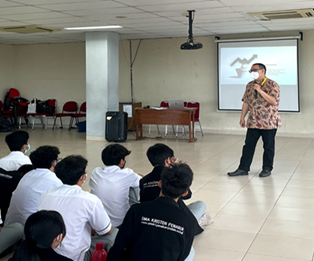Financial Literacy for the Students in Christian Senior High School 1 of BPK Penabur in Cirebon to Prepare Them to be the Intelligent Investors
Main Article Content
Abstract
Financial literacy is helpful for learners to recognize the features of the capital market and their instruments. With this knowledge, they are expected to manage their money wisely, especially in selecting the devices. Furthermore, to realize this condition, this service to the community aims to measure this literacy level and recognize risk profiles. The methods utilized in this service are lecture, discussion, and simulation. The participants in this service are the 40 students in the eleventh grade taking social science in the Christian senior high school 1 of BPK Penabur in Cirebon. Also, the precise answers of the students based on financial literacy items are used to evaluate this service. Surprisingly, the correct answers to these basic and advanced items are from 60.53% to 78.95% and 63.16% to 78.95%, respectively, indicating the middle financial level exists. This level is above the national literacy level in 2019 in Indonesia: 38.03%. Besides, related to the risk profile, most students are conservative (47.5%) and moderate (47.5%). Based on this outcome, the students with a conventional risk profile are expected to invest their money in a time-deposit account, government bonds, and fixed-income and money-market mutual funds. Meanwhile, students with a moderate risk profile should place their funds in blue-chip stocks and mixed mutual funds.
Downloads
Article Details

This work is licensed under a Creative Commons Attribution-ShareAlike 4.0 International License.
Authors who publish with this journal agree to the following terms:
- Any article on the copyright is retained by the author(s).
- Author grant the journal, right of first publication with the work simultaneously licensed under a Creative Commons Attribution License that allows others to share work with acknowledgment of the work authors and initial publications in this journal.
- Authors are able to enter into a separate, additional contractual arrangements for non-exclusive distribution of published articles of work (eg, post-institutional repository) or publish it in a book, with acknowledgment of its initial publication in this journal.
- Authors are permitted and encouraged to post their work online (e.g., in institutional repositories or on their websites) prior to and during the submission process, as can lead to productive exchanges, as well as earlier and greater citation of published work.
- The article and any associated published material is distributed under the Creative Commons Attribution-ShareAlike 4.0 International License
References
Alaaraj, H. & Bakri, A. (2020). The effect of financial literacy on investment decision-making in Southern Lebanon. International Business and Accounting Research Journal, 4(1), 37–43. https://doi.org/10.15294/ibarj.v4i1.118
Aravik, H. & Tohir, A. (2022). Improving financial literacy comprehension of students of the vocational high school of Muhammadiyah 1 in Palembang. Aksi Kepada Masyarakat, 3(1), 29–36. https://doi.org/10.36908/akm.v3i1.429
Asfira, N., Rokhmawati, A., & Fathoni, A. F. (2020). The effect of financial literacy and investment experience on risk tolerance and investment decision. Jurnal Ekonomi, 27(4), 340–352. http://dx.doi.org/10.31258/je.27.4.p.340-352
CFI Team. (2022). What is risk tolerance? Corporate Finance Institute. https://corporatefinanceinstitute.com/resources/wealth-management/risk-tolerance/
Chen, H. & Volpe, R. P. (1998). An analysis of personal financial literacy among college students. Financial Services Review, 7(2), 107–128. https://doi.org/10.1016/s1057-0810(99)80006-7
Financial Service Authority. (2019). Press conference: Public financial literacy and inclusion indexes enhanced based on financial service authority in 2019. https://www.ojk.go.id/id/berita-dan-kegiatan/siaran-pers/Pages/Siaran-Pers-Survei-OJK-2019-Indeks-Literasi-Dan-Inklusi-Keuangan-Meningkat.aspx
Hidayatinnisa, N., Fauziah, F., Trivena, S. M., & Aini, Y. N. (2021). The effect of financial literacy and financial inclusion on economic growth in Indonesia. JBMP: Jurnal Bisnis, Manajemen, & Perbankan, 7(2), 339–359. https://doi.org/10.21070/jbmp.v7vi2.1539
International Network on Financial Education. (2012). Financial students in schools. https://www.oecd.org/finance/financial-education/FinEdSchool_web.pdf
Jones, J. D. & Barrett, C. E. (2017). Simulation as a classroom teaching method. Journal on School Educational Technology, 12(4), 49–54.
Kaur, G. (2011). Study and analysis of lecture model of teaching. International Journal of Educational Planning & Administration, 1(1), 9–13
Leon, F. M. & Hadinata, C. (2018). The influence of demography and risk tolerance on portfolio investment selection of post-graduate students. Jurnal Manajemen, 22(3), 360–380. https://doi.org/10.24912/jm.v22i3.427
Lusardi, A. & Mitchell, O. S. (2009). How ordinary consumers make complex economic decisions: Financial literacy and retirement readiness. Quarterly Journal of Finance, 7(3), 1-31.
Malik, A. (2021). The low literacy level: The students are students are vulnerable to influencer persuasion. Bareksa. https://www.bareksa.com/berita/belajar-investasi/2021-08-24/tingkat-literasi-rendah-pelajar-rentan-terkena-bujuk-rayu-influencer
Mubaraq, M. R., Anshori, M., & Trihatmoko, H. (2021). The influence of financial knowledge and risk tolerance on investment decision making. Jurnal Ekonomi Bisnis & Kewirausahaan, 10(2), 140-153. https://doi.org/10.26418/jebik.v10i2.47089
Pak, O. & Mahmood, M. (2015). Impact of personality on risk tolerance and investment decisions: A study on potential investors of Kazakhstan. International Journal of Commerce and Management, 25(4), 370–384. https://doi.org/10.1108/ijcoma-01-2013-0002
Pertiwi, T. K., Wardani, N. I. K., & Septentia, I. (2020). Knowledge, experience, financial satisfaction, and investment decisions: Gender as a moderating variable. Jurnal Manajemen & Kewirausahaan, 22(1), 57–64. https://doi.org/10.9744/jmk.22.1.57-64
Pranoto, P., Fauzi, R. D., Kustini, E., Maduningtias, L., & Yuangga, K. D. (2020). Financial literacy for the vocational high school students of Sasmita Jaya. BAKTIMAS: Jurnal Pengabdian Pada Masyarakat, 2(2), 119–122. https://doi.org/10.32672/btm.v2i2.2137
Prasidya, Y. (2020). Lifestyle, lack of tech adoption, impediments to Indonesian financial literacy. The Jakarta Post. https://www.thejakartapost.com/news/2020/08/10/lifestyle-lack-of-tech-adoption-impediments-to-indonesias-financial-literacy.html
Putra, L., Silfiana, I., Khoiriyah, A., & Sacipto, R. (2020). The financial literacy application in managing the money of students. Jurnal Karya Abdi Masyarakat, 4(1), 132–135. https://doi.org/10.22437/jkam.v4i1.9830
Sumardi, S. & Habibi, P. (2022). Financial literacy training for generation Z in the vocational high school. El-Mujtama: Jurnal Pengabdian Masyarakat, 3(1), 83–92. https://doi.org/10.47467/elmujtama.v3i1.2253
Utami, N. & Sitanggang, M. L. (2021). The analysis of financial literacy and its impact on investment decisions: A study on generation Z in Jakarta. Inovbiz: Jurnal Inovasi Bisnis, 9, 33–40. https://doi.org/10.35314/inovbiz.v9i1.1840
